Let’s Plant Ontario Wildflowers
Smooth Blue Aster (Aster à feuilles lisses)
Symphyotrichum laeve
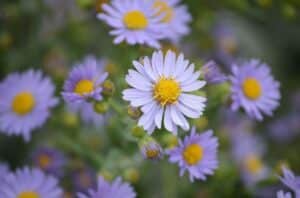
Smooth Blue Aster photo courtesy of Let’s Plant
How to germinate
This species has the germination code A, meaning there is no pre-treatment required for the seeds. Please review the online germination code handbook for more information.
How to plant
Outdoor sowing in spring, on a weed-free plot, clear of vegetation is recommended for this plant species. Place seed no deeper than ⅛ inch into the soil and light cover with soil. Gently water after seeds have been sowed.
- This plant needs full or partial sun exposure in medium-wet, medium, or medium-dry soil.
- Chelsea Chopped (a pruning method)? Yes
- Can it be aggressive? No
Characteristics
- Life cycle: Perennial
- Height: 4 feet (120 cm)
- Spread: 1–3 feet (30–90 cm)
- Bloom time: August–October
- Bloom colour: Blue
- Stratification: None
Calico Aster (Aster latériflore)
Symphyotrichum lateriflorum
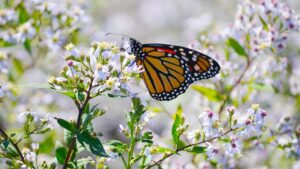
Calico Aster photo courtesy of Let’s Plant
How to germinate
This species has the germination code A, meaning there is no pre-treatment required for the seeds. Please review the online germination code handbook for more information.
How to plant
Outdoor sowing in spring, on a weed-free plot, clear of vegetation is recommended for this plant. Plant seeds spaced 18–36 inches apart.
- This plant needs full, partial sun exposure or a shaded area in medium-wet, medium, or medium-dry soil.
- Can it be chelsea chopped? Yes
- Can it be aggressive? Mildly
Characteristics
- Height: 5 feet (150 cm)
- Spread: 2–3 feet (60–90 cm)
- Bloom time: August–October
- Bloom colour: White, purple
- Stratification: None
Common Evening Primrose (Onagre Bisannuelle)
Oenothera biennis
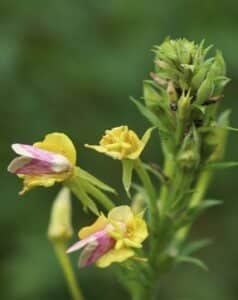
Common Evening Primrose photo courtesy of Let’s Plant
How to germinate
No pre-treatment is required for this species, but the seeds are very small or need light to naturally germinate. This means, the seeds should be surface sown with no soil cover applied, or just a light dusting. This species has the germination code A, D and G. Please review the online germination code handbook for more information.
How to plant
Outdoor sowing between late fall and early spring, on a weed-free plot, clear of vegetation is recommended for this plant.
- This plant needs full or partial sun exposure and medium-wet, medium, medium-dry, or dry soil conditions. Rocky or sandy soils are recommended.
- Can it be chelsea chopped? Yes
- Can it be aggressive? Yes
Characteristics
- Life cycle: Perennial
- Height: 6 feet (180 cm)
- Spread: 1–2 feet (30–60 cm)
- Bloom time: June–October
- Bloom colour: Yellow
- Stratification: None
Upland White Goldenrod / Upland White Aster (Verge d’or Faux-ptarmica)
Oligoneuron album / Aster Solidago ptarmicoides
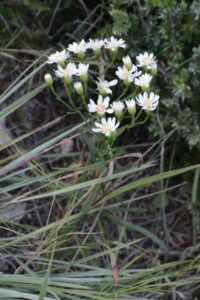
Upland White Goldenrod Upland White Aster photo courtesy of Let’s Plant
How to germinate
No pre-treatments are required for this plant. This species has a germination code A. Please review the online germination code handbook for more information.
How to plant
Outdoor sow at a depth of 1/16 inch between late fall and early spring, on a weed-free plot, clear of vegetation is recommended.
- This plant needs full sun exposure in medium-dry, dry soil conditions to grow.
- Can it be chelsea chopped? Yes
- Aggressive? No
Characteristics
- Life cycle: Perennial
- Height: 1–1.5 feet (30–45 cm)
- Spread: 0.83–1 feet (25–30 cm)
- Bloom time: June–September
- Bloom colour: White
- Stratification: None
Sneezeweed (Bois de la toux)
Helenium autumnale
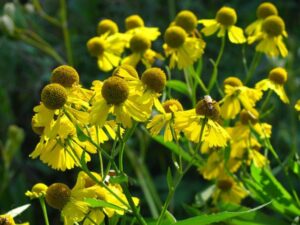
Sneezeweed photo courtesy of Let’s Plant
How to germinate
This species has the germination codes A and D. Please review the online germination code handbook for more information.
How to plant
Direct sow on a weed-free plot, at a depth of ⅛ inches.
- This plant needs full sun exposure or partial shade and wet or medium-wet soil conditions to grow.
- Can it be chelsea chopped? Yes
- Can it be aggressive? No
Characteristics
- Life cycle: Perennial
- Height: 4 feet (120 cm)
- Spread: 2–3 feet (60–90 cm)
- Blooming time: August–October
- Blooming colour: Yellow
- Stratification: None
Mountain Mint (Pycnanthème à feuilles étroites)
Pycnanthemum virginianum
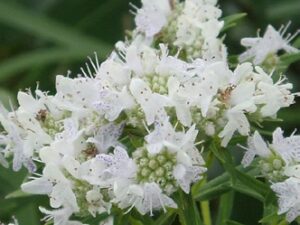
Mountain Mint photo courtesy of Let’s Plant
How to germinate
This species has the germination codes A and D. Please review the online germination code handbook for more information.
How to plant
Outdoor surface sowing in spring, on a weed-free plot, clear of vegetation is recommended for this plant species. Place seeds no deeper than ⅛ inch into the soil, making sure they are not completely buried, just lightly covered. Gently water after seeds have been sowed.
- This plant needs full or partial sun exposure and wet, medium-wet, medium, or medium-dry soil conditions to grow.
- Can it be chelsea chopped? Yes
- Can it be aggressive? Yes
Characteristics
- Life cycle: Perennial
- Height: 3 feet (90 cm)
- Spread: 1–1.5 feet (30–45 cm)
- Bloom time: June–September
- Blooming colour: White
- Stratification: None
Hoary Mountain Mint (Menthe des montagnes grises)
Pycnanthemum incanum
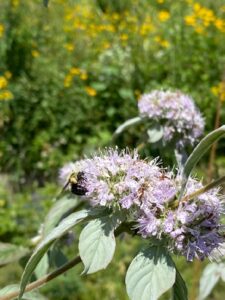
Hoary Mountain Mint photo courtesy of Let’s Plant
How to germinate
This species has the germination codes A and D. Please review the online germination code handbook for more information.
How to plant
Outdoor surface sowing in spring, on a weed-free plot, clear of vegetation is recommended for this plant species. Place seeds no deeper than ⅛ inch into the soil, making sure they are not completely buried, just lightly covered. Gently water after seeds have been sowed.
- This plant needs full or partial sun exposure and medium, medium-dry soil conditions to grow.
- Can it be chelsea chopped? Yes
- Can it be aggressive? Yes
Characteristics
- Life cycle: Perennial
- Height: 3–6 feet (90–183 cm)
- Spread: 1–1.5 feet (30–45 cm)
- Bloom time: July–September
- Blooming colour: White, purple
- Stratification: None
Purple Prairie Clover (Dalée violette)
Dalea purpurea
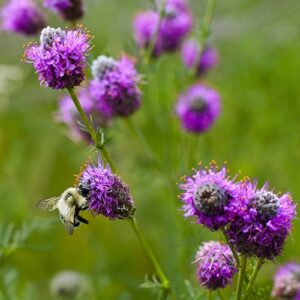
Purple Prairie Clover photo courtesy of Let’s Plant
How to germinate
This species has the germination code A, I, and J. Please review the online germination code handbook for more information.
How to plant
Direct sow at a depth of ¼ inches or 6 mm into open compact soil.
- This plant needs full sun to partial shade, and medium to dry, well-drained soils to grow.
- Can it be chelsea chopped? No
- Can it be aggressive? No
Characteristics
- Life cycle: Perennial
- Height: 1–3 feet (30–90 cm)
- Spread: 1.25–1.5 feet (38–45 cm)
- Blooming time: July–September
- Blooming colour: Purple
- Stratification: None
Wild Bergamot (Monarde Fistuleuse)
Monarda fistulosa
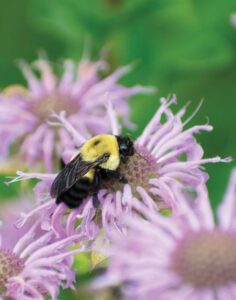
Wild Bergamot photo courtesy of Let’s Plant
How to germinate
This species has the germination code A, meaning no pre-treatment is required for it. Please review the online germination code handbook for more information.
How to plant
Direct sow on weed-free plot at a depth of ⅛ inches.
- This plant needs full or partial sun exposure, and medium-wet, medium, or medium-dry soil conditions to grow.
- Can it be chelsea chopped? Yes
- Can it be aggressive? Somewhat, but can be easily contained.
Characteristics
- Life cycle: Perennial
- Height: 2–4 feet tall (60–120 cm)
- Spread: 2–3 feet wide (60–90 cm)
- Blooming time: July–September
- Blooming colour: Purple
- Stratification: None
New England Aster (Aster de la Nouvelle-Angleterre)
Symphyotrichum novae-angliae
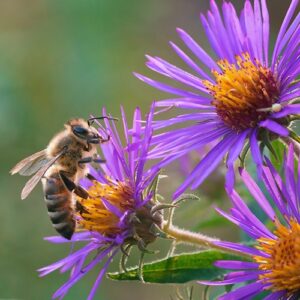
New England Aster photo courtesy of Let’s Plant
How to germinate
Most wild plant seeds have built-in dormancy mechanisms that prevent the seed from germinating. To grow these plants anywhere, you must first break this dormancy mechanism, which will allow the seed to grow. This species has specific germination instructions. It has a germination code of C(60), which means you have to artificially stratify the seeds for 60 days, or sow seeds outdoors in the fall to over-winter naturally to see germination the following spring. Please review the online germination code handbook for more information.
How to plant
Once stratification is complete, sow the seeds outdoors into rows, ⅝ inches deep into the soil. Ensure the seeds are spaced 30 cm apart.
- This plant needs full or partial sun exposure, and wet, medium-wet, medium, or medium-dry soil conditions to grow.
- Can it be chelsea chopped? Yes
- Can it be aggressive? No
Characteristics
- Life cycle: Perennial
- Height: At least 5–6 feet (150–180 cm)
- Spread: 2 to 3 feet wide (60–90 cm)
- Bloom time: August–October
- Bloom colour: Purple, pink
- Stratification: Yes
Early Sunflower (Hélopsis Faux-Hélianthe)
Heliopsis helianthoides
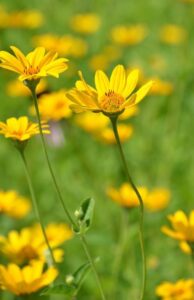
Early Sunflower photo courtesy of Let’s Plant
How to germinate
Most wild plant seeds have built-in dormancy mechanisms that prevent the seed from germinating. To grow these plants anywhere, you must first break this dormancy mechanism, which will allow the seed to grow. This species has specific germination instructions. It has a germination code of C(30), which means you have to artificially stratify the seeds for 30 days, or sow seeds outdoors in the fall to over-winter naturally to see germination the following spring. Please review the online germination code handbook for more information.
How to plant
Once stratification is complete, sow the seeds outdoors into well-weeded, thin rows, 1 inch deep into the soil. Ensure the seeds are spaced 45–90 cm apart.
- This plant needs full or partial sun exposure, and sandy, medium-wet, medium, or medium-dry soil conditions to grow.
- Can it be chelsea chopped? No
- Can it be aggressive? No
Characteristics
- Life cycle: Short-Lived Perennial
- Height: 5 feet (150 cm)
- Spread: 2–4 feet (60–120 cm)
- Blooming time: June–September
- Blooming colour: Yellow
- Stratification: Yes
Black-eyed Susan (Rudbeckie Hérissée)
Rudbeckia hirta
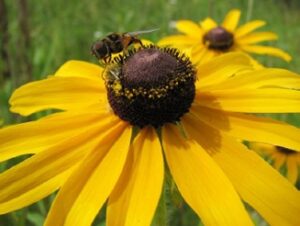
Black-eyed Susan photo courtesy of Let’s Plant
How to germinate
Most wild plant seeds have built-in dormancy mechanisms that prevent the seed from germinating. To grow these plants anywhere, you must first break this dormancy mechanism, which will allow the seed to grow. This species has specific germination instructions. It has a germination code of C(30), which means you have to artificially stratify the seeds for 30 days, or sow seeds outdoors in the fall to over-winter naturally to see germination the following spring. Please review the online germination code handbook for more information.
How to plant
Once stratification is complete, sow the seeds outdoors into well-weeded, thin rows, ⅛–½ inch deep into the soil. Ensure the seeds are spaced 30–45 cm apart.
- This plant needs full or partial sun exposure, and well-drained, medium-wet, medium, or medium-dry soil conditions to grow.
- Can it be chelsea chopped? Yes
- Can it be aggressive? Can become aggressive if there’s not enough competition.
Characteristics
- Life cycle: Biennial or Short-Lived Perennial
- Height: 2–3 feet (60–90 cm)
- Spread: 1–2 feet (30–60 cm)
- Blooming time: June–October
- Blooming colour: Yellow
- Stratification: Yes
Brown-eyed Susan (Rudbeckie Trilobée)
Rudbeckia triloba
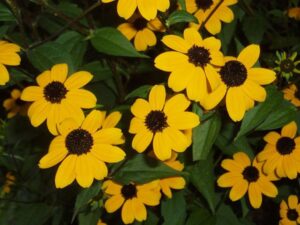
Brown-eyed Susan photo courtesy of Let’s Plant
How to germinate
Most wild plant seeds have built-in dormancy mechanisms that prevent the seed from germinating. To grow these plants anywhere, you must first break this dormancy mechanism, which will allow the seed to grow. This species has specific germination instructions. It has a germination code of C(30), which means you have to artificially stratify the seeds for 30 days, or sow seeds outdoors in the fall to over-winter naturally to see germination the following spring. Please review the online germination code handbook for more information.
How to plant
Once stratification is complete, sow the seeds outdoors into well-weeded, thin rows, ⅛–¼ inch deep into the soil. Ensure the seeds are spaced 45–60 cm apart.
- This plant needs full or partial sun exposure, and medium-wet, medium, or medium-dry soil conditions to grow.
- Can it be chelsea chopped? Yes
- Can it be aggressive? No
Characteristics
- Life cycle: Biennial or Short-Lived Perennial
- Height: 5 feet (150 cm)
- Spread: 1–2 feet (30–60 cm)
- Blooming time: August–October
- Blooming colour: Yellow
- Stratification: Yes
Rose Milkweed (Asclépiade incarnate)
Asclepias incarnata
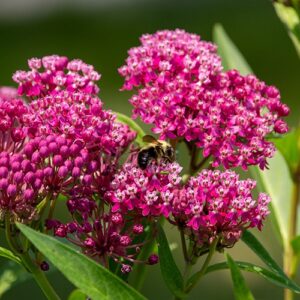
Rose Milkweed photo courtesy of Let’s Plant
How to germinate
Most wild plant seeds have built-in dormancy mechanisms that prevent the seed from germinating. To grow these plants anywhere, you must first break this dormancy mechanism, which will allow the seed to grow. This species has specific germination instructions. It has a germination code of C(30), which means you have to artificially stratify the seeds for 30 days, or sow seeds outdoors in the fall to over-winter naturally to see germination the following spring. Please review the online germination code handbook for more information.
How to plant
Once stratification is complete, sow the seeds outdoors into well-weeded, thin rows, ¼ inch deep into the soil. Ensure the seeds are spaced 45–90 cm apart.
- This plant needs full or partial sun exposure, and wet, medium-wet, or medium soil conditions to grow.
- Can it be chelsea chopped? Yes
- Can it be aggressive? No
Characteristics
- Life cycle: Perennial
- Height: 4–5 feet (120–150 cm)
- Spread: 2–3 feet (60–90 cm)
- Blooming time: June–September
- Blooming colour: Pink
- Stratification: Yes
Grass-leaved Goldenrod (Verge d’or à Feuilles de Graminée)
Euthamia graminifolia
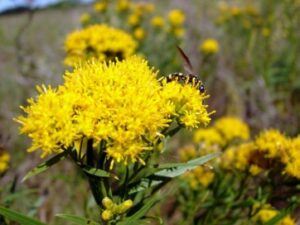
Grass-leaved Goldenrod photo courtesy of Let’s Plant
How to germinate
Most wild plant seeds have built-in dormancy mechanisms that prevent the seed from germinating. To grow these plants anywhere, you must first break this dormancy mechanism, which will allow the seed to grow. This species has specific germination instructions. It has a germination code of C(30), which means you have to artificially stratify the seeds for 30 days, or sow seeds outdoors in the fall to over-winter naturally to see germination the following spring. It also has the germination code D, meaning these seeds are very small and may need light to naturally break the dormancy mechanisms. Please review the online germination code handbook for more information.
How to plant
Once stratification is complete, surface sow the seeds on the soil, ensuring they are not covered.
- This plant needs full or partial sun exposure, and wet, medium-wet, medium, medium-dry soil conditions to grow.
- Can it be chelsea chopped? Yes
- Can it be aggressive? Yes
Characteristics
- Life cycle: Perennial
- Height: 4–5 feet (120–150 cm)
- Spread: 1–2 feet (30–60 cm)
- Blooming time: July–September
- Blooming colour: Yellow
- Stratification: Yes
Stiff Goldenrod (Verge d’or Rigide)
Oligoneuron rigidum
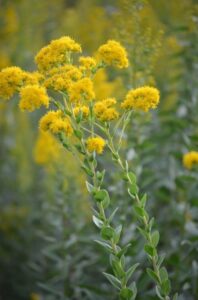
Stiff Goldenrod photo courtesy of Let’s Plant
How to germinate
Most wild plant seeds have built-in dormancy mechanisms that prevent the seed from germinating. To grow these plants anywhere, you must first break this dormancy mechanism, which will allow the seed to grow. This species has specific germination instructions. It has a germination code of C(60), which means you have to artificially stratify the seeds for 60 days, or sow seeds outdoors in the fall to over-winter naturally to see germination the following spring. Please review the online germination code handbook for more information.
How to plant
Once stratification is complete, sow the seeds outdoors into rows, ⅛ inch deep into the soil. Ensure the seeds are spaced 30 cm apart.
- This plant needs full or partial sun exposure, and medium-wet, medium, medium-dry, or dry soil conditions to grow.
- Can it be chelsea chopped? Yes
- Can it be aggressive? No
Characteristics
- Life cycle: Perennial
- Height: 4–5 feet (120–150 cm)
- Spread: 1.5–2.5 feet (45–75 cm)
- Blooming time: August–October
- Blooming colour: Yellow
- Stratification: Yes
Early Goldenrod (Verge d’or Jonciforme)
Solidago juncea
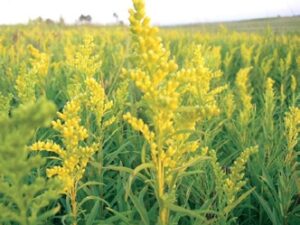
Early Goldenrod photo courtesy of Let’s Plant
How to germinate
Most wild plant seeds have built-in dormancy mechanisms that prevent the seed from germinating. To grow these plants anywhere, you must first break this dormancy mechanism, which will allow the seed to grow. This species has specific germination instructions. It has a germination code of C(60), which means you have to artificially stratify the seeds for 60 days, or sow seeds outdoors in the fall to over-winter naturally to see germination the following spring. It also has the germination code D, meaning these seeds are very small and may need light to naturally break the dormancy mechanisms. Please review the online germination code handbook for more information.
How to plant
Once stratification is complete, surface sow the seeds ⅛ inch deep into the soil, ensuring they are only lightly covered with soil.
- This plant needs full or partial sun exposure, and medium, medium-dry, or dry soil conditions to grow.
- Can it be chelsea chopped? Yes
- Can it be aggressive? Yes
Characteristics
- Life cycle: Perennial
- Height: 3–4 feet (90–120 cm)
- Spread: 2–3 feet (60–90 cm)
- Blooming time: July–September
- Blooming colour: Yellow
- Stratification: Yes
Showy Goldenrod (Verge d’or élégante)
Solidago speciosa
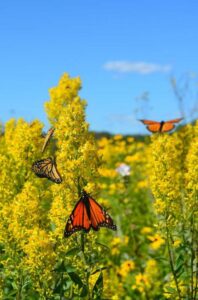
Showy Goldenrod photo courtesy of Let’s Plant
How to germinate
Most wild plant seeds have built-in dormancy mechanisms that prevent the seed from germinating. To grow these plants anywhere, you must first break this dormancy mechanism, which will allow the seed to grow. This species has specific germination instructions. It has a germination code of C(60), which means you have to artificially stratify the seeds for 60 days, or sow seeds outdoors in the fall to over-winter naturally to see germination the following spring. It also has the germination code D, meaning these seeds are very small and may need light to naturally break the dormancy mechanisms. Please review the online germination code handbook for more information.
How to plant
Once stratification is complete, surface sow the seeds ⅛ inch deep into the soil, ensuring they are only lightly covered with soil.
- This plant needs full or partial sun exposure, and rocky or clay soils, with medium, medium-dry, or dry soil conditions to grow.
- Can it be chelsea chopped? Yes
- Can it be aggressive? No
Characteristics
- Life cycle: Perennial
- Height: 5–6 feet (150–180 cm)
- Spread: 2–3 feet (60–90 cm)
- Blooming time: August–November
- Blooming colour: Yellow
- Stratification: Yes
Lance-leaf Coreopsis (Coréopsis lancéolé)
Coreopsis lanceolata
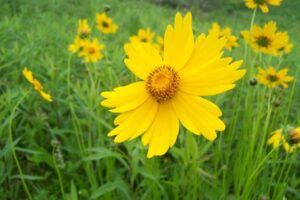
Lance-leaf Coreopsis photo courtesy of Let’s Plant
How to germinate
Most wild plant seeds have built-in dormancy mechanisms that prevent the seed from germinating. To grow these plants anywhere, you must first break this dormancy mechanism, which will allow the seed to grow. This species has specific germination instructions. It has a germination code of C(30), which means you have to artificially stratify the seeds for 30 days, or sow seeds outdoors in the fall to over-winter naturally to see germination the following spring. Please review the online germination code handbook for more information.
How to plant
Once stratification is complete, sow the seeds outdoors into well-weeded, thin rows, ⅛ inch deep into the soil. Ensure the seeds are spaced 20–45 cm apart.
- This plant needs full sun exposure, and medium-dry or dry soil conditions to grow.
- Can it be chelsea chopped? Yes
- Can it be aggressive? Yes
Characteristics
- Life cycle: Perennial
- Height: 2 feet (60 cm)
- Spread: 1–2 feet (30–60 cm)
- Blooming time: May–August
- Blooming colour: Yellow
- Stratification: Yes
Showy Milkweed (Belle Asclépiade)
Asclepias speciosa
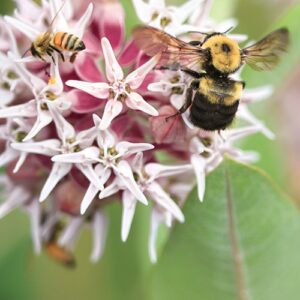
Showy Milkweed photo courtesy of Let’s Plant
How to germinate
Most wild plant seeds have built-in dormancy mechanisms that prevent the seed from germinating. To grow these plants anywhere, you must first break this dormancy mechanism, which will allow the seed to grow. This species has specific germination instructions. It has a germination code of C(30), which means you have to artificially stratify the seeds for 30 days, or sow seeds outdoors in the fall to over-winter naturally to see germination the following spring. Please review the online germination code handbook for more information.
How to plant
Once stratification is complete, sow the seeds outdoors into well-weeded, thin rows, ⅛ inch deep into the soil. Ensure the seeds are spaced 20–45 cm apart.
- This plant needs full sun exposure, and medium, medium-dry, or dry soil conditions to grow.
- Can it be chelsea chopped? Yes
- Can it be aggressive? Yes
Characteristics
- Life cycle: Perennial
- Height: 3 feet (90 cm)
- Spread: 1–2.5 feet (30–75 cm)
- Blooming time: June–August
- Blooming colour: Purple
- Stratification: Yes
Narrow-leaved Coneflower (Échinacée à Feuilles Étroites)
Echinacea angustifolia
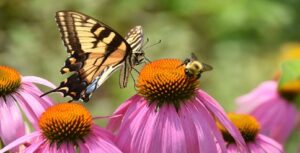
Narrow-leaved Coneflower photo courtesy of Let’s Plant
How to germinate
Most wild plant seeds have built-in dormancy mechanisms that prevent the seed from germinating. To grow these plants anywhere, you must first break this dormancy mechanism, which will allow the seed to grow. This species has specific germination instructions. It has a germination code of C(90) and M, which means you have to artificially stratify the seeds for 90 days, and these seeds are best planted outdoors during the fall so they can germinate in the following spring. If premature sprouting occurs, plant immediately. Please review the online germination code handbook for more information.
How to plant
Once stratification is complete, sow the seeds outdoors into well-weeded, thin rows, ⅛ inch deep into the soil. Ensure the seeds are spaced 30 cm apart.
- This plant needs full sun exposure, and medium-dry or dry soil conditions to grow.
- Can it be chelsea chopped? Yes
- Can it be aggressive? No
Characteristics
- Life cycle: Perennial
- Height: 2 feet (60 cm)
- Spread: 1–1.5 feet (25–45 cm)
- Blooming time: June–July
- Blooming colour: Pink
- Stratification: Yes
